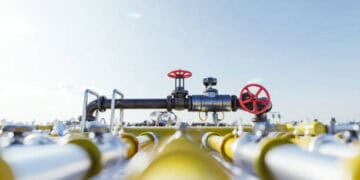Recent data reveals that carbon dioxide emissions from U.S. liquefied natural gas (LNG) facilities have seen a significant rise, reaching 18 million tons annually, marking an 81% increase since 2019. These emissions are equivalent to the greenhouse gas output of several large coal plants. Projections provided to regulatory bodies, including the U.S. Environmental Protection Agency (EPA) and the Federal Energy Regulatory Commission (FERC), indicate that these emissions could potentially more than double to 45 million tons annually by the end of the decade. This increase is driven by the construction of new facilities responding to the growing demand for super-cooled LNG abroad.
The rise in emissions poses a complex challenge for the Biden administration, which aims to expand fuel exports to European allies while simultaneously reducing greenhouse gas emissions domestically to combat climate change. The administration sees U.S. LNG as a means to help Europe reduce its reliance on Russian gas supplies, particularly given Russia’s facing of Western sanctions due to its actions in Ukraine. This support led to the approval of five U.S. LNG export licenses for the European market following Russia’s invasion, whereas none were approved previously.
The surge in emissions from the LNG sector stems from both existing facilities and upcoming projects. In 2022, carbon dioxide emissions from all seven operational U.S. LNG export facilities totaled 17.6 million tons, marking an 81% increase since 2019 when the sector had six facilities, according to EPA data. Projections indicate that as five projects currently under construction come online by 2028, they will produce an additional 27 million tons of emissions annually. This could result in over 45 million tons per year of emissions by the end of the decade, roughly equivalent to 2.5% of current carbon emissions from the U.S. power industry.
Additionally, some LNG exporters have postponed or abandoned plans to implement carbon capture and sequestration (CCS) technologies to reduce emissions, casting doubt on the feasibility of this technology as a large-scale solution for addressing the industry’s climate impact. It’s important to note that CO2 emissions from the energy-intensive process of liquefying gas for export represent only one aspect of the industry’s overall climate impact. Methane leaks that occur during drilling, piping, shipping, and distribution contribute to pollution even before the fuel is consumed.
Advocates of LNG argue that it offers a cleaner alternative to coal, emphasizing its potential role in transitioning to a low-carbon future by complementing renewable energy sources like solar and wind.
However, critics raise concerns about whether the surge in U.S. LNG exports to Europe is genuinely displacing coal or potentially delaying the transition to renewables. The precise impact on coal consumption in overseas markets remains uncertain.
Furthermore, despite initial announcements of CCS projects by some LNG operators, doubts have emerged regarding their implementation. Operators have postponed or questioned the economic viability of such initiatives, raising questions about the industry’s commitment to reducing emissions.
In conclusion, the growth in U.S. LNG exports to Europe has led to an increase in CO2 emissions from LNG facilities, posing a multifaceted challenge for the Biden administration’s climate goals. The industry’s impact on emissions and its commitment to emission-reduction technologies continue to be subjects of debate and scrutiny.
Breaking supply chain news is just a click away at The Supply Chain Report. Enhance your knowledge of international trade at ADAMftd.com with free tools.
#SandTraceability #SustainableSandExtraction #ConstructionResources #SandMining #GeologicalComplexity #SandProvenance #MachineLearningInMining #SandId #SustainableDevelopmentGoals #ConstructionAggregate #EnvironmentalImpact #SandCertification #UniversityOfTexas #UniversityOfCalifornia #UniversityOfAlicante #SandMiningConflict #SmartMiningSolutions #OECD #BiodiversityRisks

















